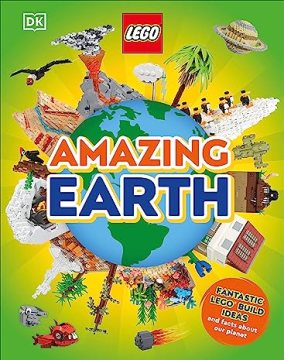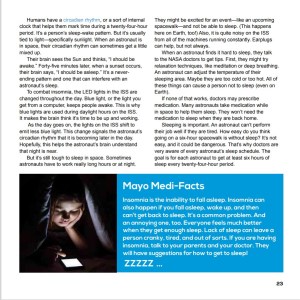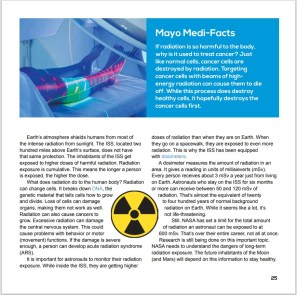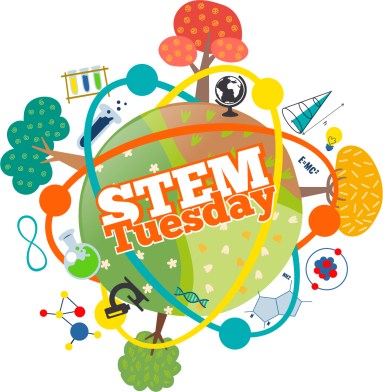 We’re excited to have Jennifer Swanson on here today to talk about her two new releases. Let’s start with learning a bit more about her, and then we’ll talk more about both of her books, Spacecare: The Kids Guide to Surviving Space and LEGO: Amazing Earth.
We’re excited to have Jennifer Swanson on here today to talk about her two new releases. Let’s start with learning a bit more about her, and then we’ll talk more about both of her books, Spacecare: The Kids Guide to Surviving Space and LEGO: Amazing Earth.
So, Jen, did you love to read as a child? If so, can you tell us some favorite books?
I read EVERYTHING! Every summer my library had a contest to read the most books. I won almost every year. I read so many books. Fiction, nonfiction, science, history, adventure, and more. I think my favorite books are mysteries. They still are. Of course, I read all of the Nancy Drew books, the Hardy Boys, and Trixie Belden as well.
When did you know you wanted to be a writer?
I have been writing my whole life. I used to write books when I was in kindergarten and early elementary school. As I got older, I kept journals. I didn’t fully decide to become a writer until I was much older and a stay-at-home mom with three kids. It was a busy time, but writing was my outlet and I loved it.
Have you had any careers besides writing?
Yes, I’ve been a science teacher for over 14 years. I’ve taught middle school science, forensics science, and high and junior college level chemistry.
That sounds like you have the perfect background to write these science-based books. Is that what drew you to writing nonfiction?
I am a curious person and have lots of questions about how things work. LOTS! One of my mom’s favorite sayings to me when I was a kid was, “Go look it up!”. And I did. I was a totally Jeopardy kid. Because I love facts! And I love learning. So, for me, writing nonfiction is all about making those facts FUN for kids. It’s getting them to be curious, and wanting to imagine, explore, and investigate to learn more.
And now that we know about more about Jennifer, let’s find out about more about her books about space and LEGOs.


Jen, what inspired you to write about these topics?
Both of these books were actually work-for-hire projects, so I was given the topics to write about. But, let me tell you, I was THRILLED to be able to write them both.
I have long been a HUGE fan of space, medicine, and LEGOs.
From the time I was 9, I wanted to be a doctor. At first a pediatrician, then a heart surgeon, then an organ-transplant surgeon. When I was in high school, Sally Ride, went up in the space shuttle for the first time. I was hooked. My new goal – the first female astronaut organ-transplant surgeon. (That sounds like an amazing goal!!)
While, clearly none of that happened, writing Spacecare allowed me to share my passions for both topics.
As for LEGOs, well, I’ve been building with them since I was old enough to put them together. My childhood was spent engineering and building many different creations. I’m old enough to have been around when you just bought the blocks and there weren’t instructions, so you designed your own stuff. My kids loved LEGOs, and our house is still filled with them. Taking my love of LEGOs and combining it with science? Yes, please. Writing this book was simply AMAZING!
Can you tell us a little about the books?
How about I show you. Here are a few spreads from SpaceCare: The Kids Guide to Surviving Space (Mayo Clinic Press/Smithsonian Institution)




I was lucky enough to get a sneak peek at this book, and it’s fascinating. Did you ever wonder how people eat in space or go to the bathroom? Remember they don’t have gravity like we do on Earth. What’s microgravity? How do you keep yourself from floating around when you sleep? Jen covers all this and so much more. The pictures are amazing.
If you’re a LEGO-fan, you won’t want to miss this one:
Here are a few spreads from LEGO: Amazing Earth (DK Books)


Not only do you learn to construct many new things with LEGOs, but you’ll also learn fun facts as the sample pages show.
To find all this great information, Jen, where did you go to do your research?
Most of my research for the Spacecare book was done online. NASA has some amazing websites. But I also went to NASA Kennedy’s Space Center, and NASA Johnson’s Space Center, too. I spoke with a few experts, including Dr. Mike Harrison, doctor at the Mayo Clinic and now the Chief Medical Officer for Axiom Space. I was also lucky enough to speak with Astronaut Megan McArthur as well.
Wow! That must have been exciting to go to the space centers and speak to the doctor and an astronaut! And Astronaut Megan McArthur wrote a note at the beginning of the book.
For the LEGO: Amazing Earth book, I did a lot of online research at highly regarded content websites, as well as did some interviews with scientists, too.
With all the unusual information you discovered while researching, what was one of the most interesting facts you learned?
In Spacecare, there were so many facts, it’s hard to pick. I think I would have to say that the fact that when you’re in microgravity, your stomach floats up so that you don’t always feel hungry. That was intriguing to me. (It is to me too.)
For the LEGO book, I’d have to say that seeing how these ecosystems were designed by the LEGO experts was my favorite part. I knew I wanted to include them, but I had no idea what they would look like. (That is fascinating!)
What do you hope readers will take away from your book?
I hope readers will be fascinated by new facts, inspired by the amazing science and technology, and go out and explore the world around them.
I’m sure these books will inspire them! I know they inspired me.
Can you tell us about some of your other books?
I am the author of about 50 books for kids. I love STEM of all kinds, but I also have history and biography books, too. You can find all of my books, free teacher guides, videos, and more on my website https://jenniferswansonbooks.com/
I also have a science podcast for kids (of all ages). Check it out! https://solveitforkids.com/
What are you working on now?
I just completed final edits on my MG NF book, The Lost Forest: An Unexpected Discovery Beneath the Waves (Millbrook Press, April 2024). It follows a group of scientists who were the only ones to investigate an underwater forest.
I am working on edits for a book called Who Owns the Moon? (Margaret Quinlan Books, Jan 2025), cowritten with Cynthia Levinson.
And I’m in edits on the next Atlas Obscura book which releases from Workman Publishing in 2025.
Those all sound like great reads. We’ll look forward to seeing them when they come out.
Thanks so much for having me!
You’re welcome, Jennifer. It’s been a pleasure.
About Jennifer Swanson
Jennifer Swanson is the author of 40+ nonfiction books for kids. She is the creator and cohost of the Solve It! For Kids podcast which, in its two years of being on air, has 40k+ downloads, is ranked in the top 5% of all podcasts Worldwide, and is #1 in the Top 10 Best Podcasts for Learning by All Digital School. Her passion for science and technology resonates in all of her books but especially, Brain Games, named one of the 50 Best Science Books Ever by ThePlanets.org, Astronaut-Aquanaut, BEASTLY Bionics, and Parents’ Choice Gold Award Winner, Save the Crash-test Dummies. Her books have received starred reviews, been on the Booklist ‘Best Tech’ books list, won a Green Earth Book Honor Award, three Florida Book Awards, California Reading Association awards, and multiple National Science Teaching BEST STEM awards. Jennifer’s Outdoor School: Rocks, Fossils, and Shells book was named a 2021 Kirkus Best Books of the Year, and her Save the Crash-test Dummies book received a Parent’s Choice GOLD Award. Jennifer is an accomplished speaker at events and schools around the country, the Highlights Foundation, the National NSTA conferences, the World Science Festival in NYC, and the Library of Congress’ National Book Festival. You can find Jennifer through her website www.JenniferSwansonBooks.com.

















 In World Without Fish, the subject is of course fish. The content is what is happening to fish, the impact of fishing, and possible solutions to maintaining the oceans environmentally and economically. Now this might be exciting to read just the text, but to some students, it might not. So the publishing team has taken creativity to the form – the book and type design, the colors, the styles and size – to make a book where the content fairly jumps off the page and engages young readers with energy. It includes a comic series that appears at regular intervals throughout the book. So we have the art of “visual narrative” to further the content and engage all types of learners.
In World Without Fish, the subject is of course fish. The content is what is happening to fish, the impact of fishing, and possible solutions to maintaining the oceans environmentally and economically. Now this might be exciting to read just the text, but to some students, it might not. So the publishing team has taken creativity to the form – the book and type design, the colors, the styles and size – to make a book where the content fairly jumps off the page and engages young readers with energy. It includes a comic series that appears at regular intervals throughout the book. So we have the art of “visual narrative” to further the content and engage all types of learners.


 England, and a lifelong learner. Her publishing credits include picture books, poetry, articles, and illustration. Her latest publishing project is an anthology with her writers’ group, the Magic Storymakers, titled Kaleidoscope for Kids.
England, and a lifelong learner. Her publishing credits include picture books, poetry, articles, and illustration. Her latest publishing project is an anthology with her writers’ group, the Magic Storymakers, titled Kaleidoscope for Kids.